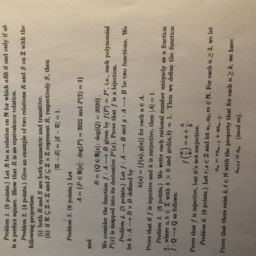尽管至少早在古希腊时代,人们就开始研究实数线,但直到1872年,实数线才被严格地定义。而自始至终,它一直是在数学的许多分支中扮演重要角色的实例。
实数轴上的拓扑最为基本同时它又通过笛卡尔乘积的形式诱导了$\mathbb{R}^n$上面的拓扑,所以熟练的掌握它对于后续的学习是非常必要的。
下面是一些典型的Math 115A 前期的assignment(实轴上的拓扑)中可能会出现的典型题目。
b) Show that any open interval $I=(a, b)$ is the countable infinite union of closed intervals.
(b) Let $N$ be large enough so that $b-a>\frac{2}{N}$ (so that we do not get empty set in the union, but it is also fine if you include many emtpy sets). Then $(a, b)=\bigcup_{n=N}^{\infty}[a+1 / n, b-1 / n]$.
a) Show that if $\left\{U_{\lambda}\right\}_{\lambda \in A}$ is any collection of open subsets, then $U=\bigcup_{\lambda \in A} U_{\lambda}$ is open.
b) Show that if $U_{1}, \ldots, U_{n}$ is a finite collection of open subsets, then $U=U_{1} \cap \ldots \cap U_{n}$ is open.
c) Show by example, that there is a countable infinite collection of open subsets $\left\{U_{n}\right\}_{n \in \mathbb{N}}$ so that $V=$ $\bigcap_{i=1}^{\infty} U_{i}$ is not open.
(b) Let $x \in U,$ then $x \in U_{i}$ for each $i=1, \ldots, n .$ By definition there are open intervals $I_{1}, \ldots I_{n}$ such that $x \in I_{i} \subset U_{i} .$ Without loss of generality, and after possibly shrinking $I_{i},$ we can assume $I_{i}=\left(x-a_{i}, x+a_{i}\right)$ for $a_{i} \in \mathbb{R}$. Now choose a real number $a<\min \left\{a_{1}, \ldots, a_{n}\right\},$ it follows that $(x-a, x+a) \subset I_{i} \subset U_{i}$ for each $i=1, \ldots, n,$ and hence $(x-a, x+a) \subset \bigcap_{i=1}^{n} U_{i}=U,$ so $U$ is
open.
(c) The example is the same as Problem 1 (a). We will show that the closed interval (as the name suggests) $[a, b]$ is not open. In fact, any open interval around $b$ will not be fully contained in $[a, b]$. Indeed, any interval around $b$ contains an interval of the form $(b-\varepsilon, b+\varepsilon)$ for some $\varepsilon>0,$ and it is clear that $b+\varepsilon / 2 \notin[a, b]$.
Determine if the following series converge and if they do find their limit. Please justify your answer rigorously.
a) $\left\{\frac{n}{n+1}\right\}_{n=1}^{\infty}$.
b) $\left\{\frac{(-2)^{n}}{n^{2}}\right\}_{n=1}^{\infty}$
$$
\left|\frac{n}{n+1}-1\right|=\frac{1}{n+1}<\frac{1}{N}<\varepsilon
$$
So the limit is 1 by definition.
(b) We claim that the limit does not exist. Suppose for a contradiction that $L \in \mathbb{R}$ is the limit of the sequence. We must exhibit an $\varepsilon$ such that there is no $N \in \mathbb{N}$ such that
$$
\left|\frac{(-2)^{n}}{n^{2}}-L\right|<\varepsilon
$$
for all $n>N$. We will show this using $\varepsilon=1$. Let $n$ be even and by triangle in equality we have
$$
\left|\frac{(-2)^{n}}{n^{2}}-L\right| \geq \frac{2^{n}}{n^{2}}-L
$$
Now since $2^{n}$ grows much faster than $n^{2}$, given any $N \in \mathbb{N},$ we can choose an even number $n>N$ large so that
$$
\frac{2^{n}}{n^{2}}>L+2
$$
and it follows
$$
\left|\frac{(-2)^{n}}{n^{2}}-L\right|>L+2-L>2>1
$$
a contradiction, so the limit must not be equal to $L$ for any $L \in \mathbb{R} .$ Hence the limit must not exist.
Let $\left\{x_{n}\right\}_{n=1}^{\infty}$ be a convergent monotone sequence. If $\lim _{n \rightarrow \infty} x_{n}=x_{k}$ for a fixed $k$, then $x_{n}=x_{k}$ for all $n \geq k$
Without loss of generality we may suppose $\left\{x_{n}\right\}$ is nondecreasing (otherwise consider $\left\{-x_{n}\right\}$ ). Suppose for a contradiction that there is some $N>k$ such that $x_{N}>x_{k}$ (since the sequence is nondecreasing $\left.x_{N} \geq x_{k}\right) .$ Let $\varepsilon=x_{N}-x_{k},$ it follows from monotonicity that
$$
\left|x_{n}-x_{k}\right|=x_{n}-x_{k} \geq x_{N}-x_{k}>\varepsilon
$$
for every $n \geq N,$ so $x_{k}$ clearly cannot be the limit of the sequence, a contradiction.
a) Let $\left\{I_{n}\right\}_{n \in \mathbb{N}}$ be a collection of closed bounded intervals with $I_{n+1} \subset I_{n}$ for all $n \geq 1$. Show that $\bigcap_{n=1}^{\infty} I_{n}$ is non-empty.
b) Let $\left\{J_{n}\right\}_{n \in \mathbb{N}}$ be a collection of open bounded intervals with $J_{n+1} \subset J_{n}$ for all $n \geq 1$. Show by example that it is possible for $\bigcap_{n=1}^{\infty} J_{n}$ to be empty.
$$
a-a_{n}<\varepsilon=a-b_{n_{0}}<a-b_{n} \Longrightarrow b_{n}<a_{n}
$$
a contradiction, since the intervals are assumed to be nonempty. This proves $a \leq b_{n}$ for every $n$ and so $a \in I_{n}$ for every $n,$ which in turn implies $a \in \bigcap_{n=1}^{\infty} I_{n}$.
(b) Consider $J_{n}=(0,1 / n),$ then $\bigcap_{n=1}^{\infty} J_{n}=\emptyset$.

real analysis代写, math 115A代写,实分析代写, 数学分析代写请认准UpriviateTA. UpriviateTA为您的留学生涯保驾护航。
更多内容请参阅另外一份Math115代写.


